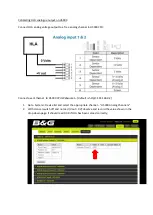
EVS1000 Blot units
3
Electroblotting
Setting up the blot sandwich
Each blot sandwich should be set up as follows:
•
Cassette clamp [-ve] (black) side placed in a tray or other suitable surface.
•
Pre-soaked fibre pad (note two can be used with thin gels).
•
Two pieces of thick filter paper, about 2...3 mm thick, pre-soaked in buffer.
•
Gel.
•
Transfer membrane. Usually this requires pre-soaking but consult the
manufacturer’s
instructions for the type of membrane you are using. This should be smoothed so that no air
bubbles have been trapped.
•
Two pieces of thick filter paper, about 2...3 mm thick, pre-soaked in buffer.
•
Pre-soaked fibre pad (note two can be used with thin gels).
•
Cassette clamp [+ve] (red) side slotted into the groove in the bottom of the black cassette.
Close the hinge carefully so as to not disturb the sandwich.
Fill the tank with buffer solution up to the maximum fill line indicated on the side of each unit.
Improved transfer can usually be obtained by using chilled buffer.
Buffer Volume
EVS1100
EVS1200
EV1300
One cassette
1380 ml
2800 ml
5600 ml
Two cassettes
1290 ml
2620 ml
5240 ml
Three cassettes
1200 ml
2440 ml
4880 ml
Four cassettes
1110 ml
2260 ml
4520 ml
Each cooling pack will take the place of 100 ml of buffer for EVS1100 and 500 ml of buffer for
EVS1200 and EVS1300.
Blot run conditions
Insert the cassettes into the slots in the module with the black side of each adjacent to the negative
electrode. It is a good idea to note the orientation and order the blot sandwiches were loaded in. This
can be done by noting which samples were loaded adjacent to each electrode.
Use of a magnetic stirring bar and plate is recommended to mix the buffer to give consistency of
transfer. A 4 mm diameter stirring bar should be placed underneath the module, in the centre of the
tank. The cooling pack provided, pre-frozen, can be inserted at the side or front of the tank for
extended blots. Additional cooling packs can be purchased as accessories to further aid cooling.
Insert the module, fit the lid and connect to a power supply.
Consult below table for details on recommended power supply voltage settings and blot times. Please
note voltage and current will vary according to the amount of cassettes, type and temperature of
Summary of Contents for EV1300
Page 1: ...EVS1000 BLOT series MANUAL Rev 44 2019 ...
Page 2: ......
Page 9: ...EVS1000 Blot units 6 Certificate ...
Page 11: ...EVS1000 Blot units 8 ...





























